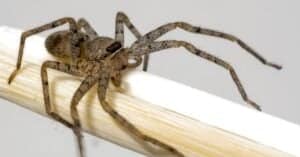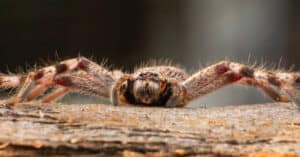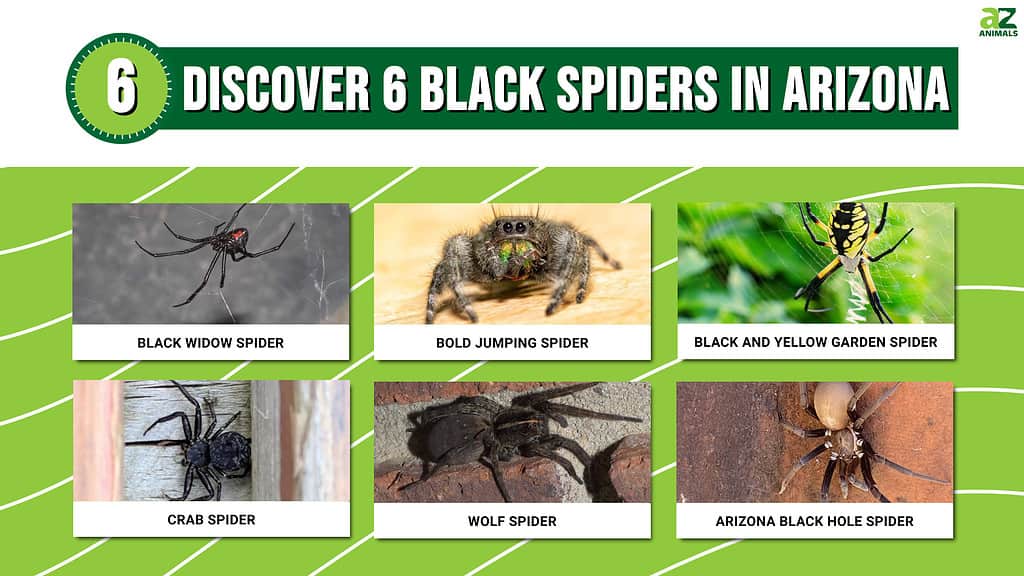
From harmless common house spiders to intimidating tarantulas, these eight-legged creatures surprise us with their inky black color and speed. Arizona is a beautiful state with diverse wildlife species, including many spiders. Spiders play an essential role in the ecosystem by controlling insect populations and providing food for birds and lizards. While some of these arachnids are harmless or beneficial to humans, others can be dangerous if improperly handled. Whether you’re an arachnid enthusiast or curious about what lurks in your backyard, join us in exploring black spiders in Arizona. We’ll discuss their characteristics and behaviors, so you can identify them in the wild.
1.) Black Widow Spider
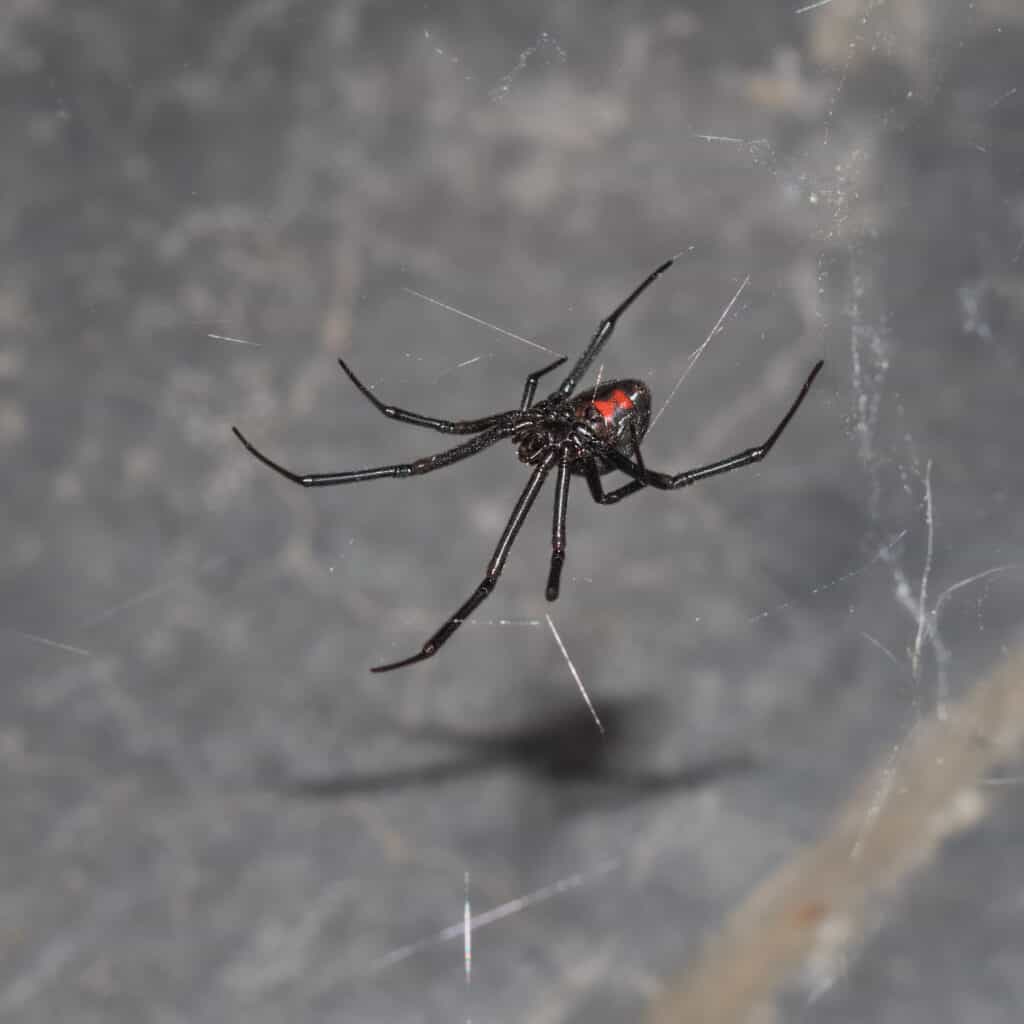
A female Western Black Widow waits in her web for potential prey. These remarkable spiders have a highly toxic venom but are very passive, shy creatures. Their silk is one of the strongest natural silks and they feed on cockroaches, earwigs, beetles, flies, and even other spiders.
©iStock.com/Shravan Sundaram Photography
The black widow spider is one of the most recognizable species of spider in Arizona. It is easily identifiable by its glossy black body and bright red hourglass-shaped abdominal marking.
These spiders are found throughout the state, most commonly in urban areas and around houses. Although their bite is not usually deadly, these spiders should still be cautiously handled. Their venom can cause muscle spasms, nausea, dizziness, and difficulty breathing.
Black widow spiders build irregularly shaped webs that hang upside down from trees or other structures.
These black spiders can vary significantly in size, ranging from a few millimeters up to 2 inches. They are nocturnal creatures and actively hunt their prey during the night. Males are significantly smaller than females and lack the iconic red hourglass marking on their abdomens.
2.) Bold Jumping Spider
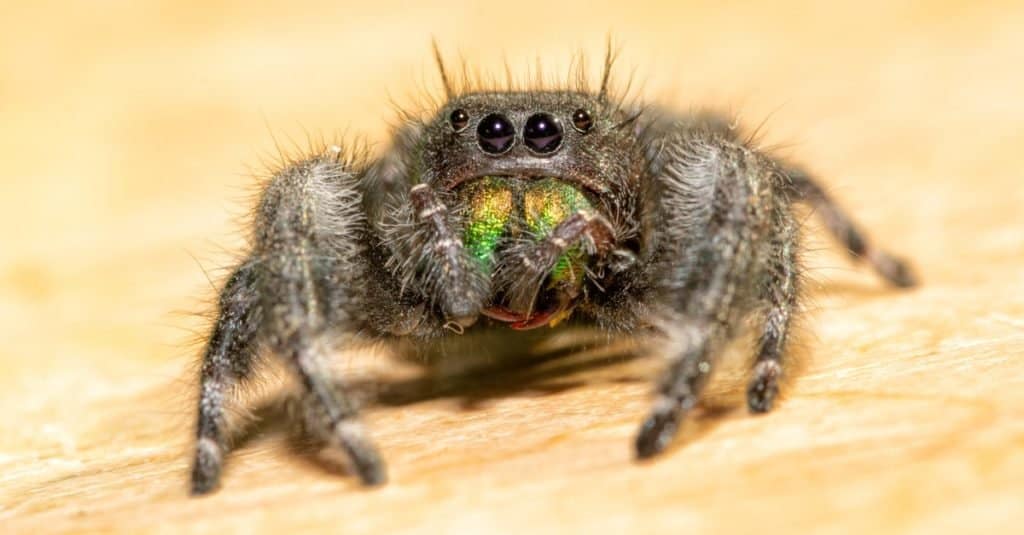
Bold jumping spiders actively target the area around them, searching for potential prey on the ground or any other surface.
©Sari ONeal/Shutterstock.com
The bold jumping spider is tiny and can grow up to 1/2 inch in length. While they may appear harmless, these spiders can be hostile when threatened and jump toward their prey if provoked. They have excellent vision and can spot movement up to 8 inches away, making them efficient hunters.
These spiders are unique due to their aggressive behavior and active hunting techniques. They use their eyesight to find prey rather than waiting for insects to fall into their webs. Bold jumping spiders actively target the area around them, searching for potential prey on the ground or any other surface. When encountering an insect, they jump!
These spiders feed on insects such as moths, flies, ants, beetles, and grasshoppers. Occasionally they eat smaller arachnids, like fellow jumping spiders. In addition to providing food for larger animals, these spiders also act as natural pest control by keeping insect populations down.
3.) Black and Yellow Garden Spider
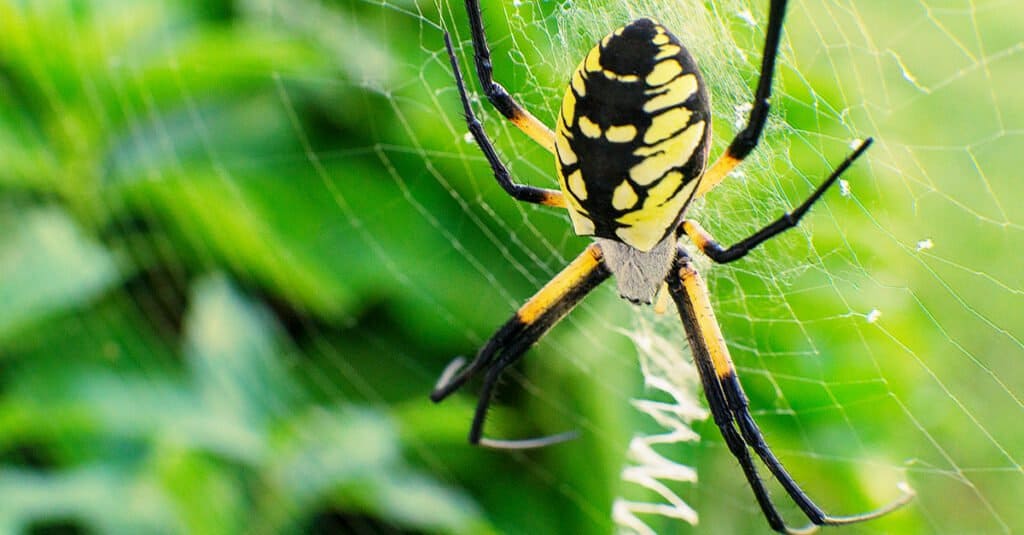
These garden spiders spin large orb webs that measure up to 18 inches across.
©Theodore P. Webb/Shutterstock.com
The black and yellow garden spider can grow up to 1 ½ inches long, with females typically larger than males. With bright yellow and black bodies, you can easily spot them, even during the day when most other spiders are out of sight.
These spiders spin large orb webs that measure up to 18 inches across. The webs are strong enough to catch giant insects such as butterflies and moths., making them an effective form of pest control for homeowners in Arizona. Unlike other species of black spiders, these spiders do not possess any venom or spinnerets, making them harmless to humans.
When threatened, black and yellow garden spiders will drop from their webs and play dead to deter potential predators. However, this does not work against other members of the same species, which often become cannibalistic. When the mating season rolls around, these spiders engage in an elaborate courtship ritual. The male and female display vibratory communications through the web that signal a desire to mate.
In terms of diet, these spiders feed mainly on small insects like mosquitoes, flies, and beetles. They have also been known to eat small lizards or frogs if available. Adult black and yellow garden spiders live only for about one year before dying out naturally. However, some may survive up to two years or more if conditions are favorable.
4.) Crab Spider
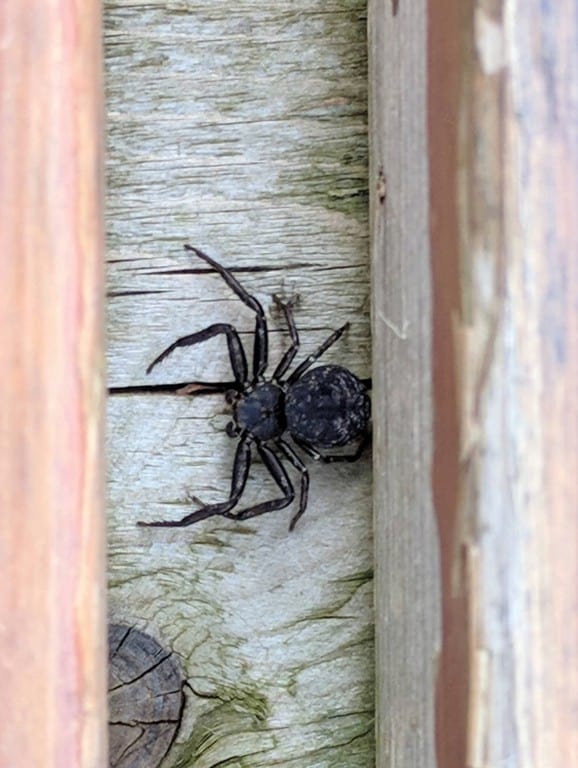
These spiders are easily distinguishable by their crab-like legs. They even scuttle sideways.
©Dirkvent / CC BY-SA 4.0 – License
The crab spider is one of Arizona’s most unique species of black spiders. These spiders are easily distinguishable by their long, crab-like legs. They even scuttle sideways like a crab across a beach. Unlike other spider species, they do not typically build webs and instead hunt their prey directly and aggressively.
These spiders feed mainly on small flying insects, such as mosquitos, flies, and moths. Larger specimens may take down even larger prey items such as frogs or lizards. They are known for their stealthy movements, which allow them to sneak up on unsuspecting prey. Due to their flattened shape, they often hide undetected amongst leaves, before attacking unsuspecting bugs.
These spiders engage in “dance mating.” The male dances around the female while vibrating to signal his desire to mate with her. The female accepts or refuses the offer, depending on her interests. If she accepts, she usually eats him afterward. This post coital cannibalism can be quite gruesome.
5.) Wolf Spider
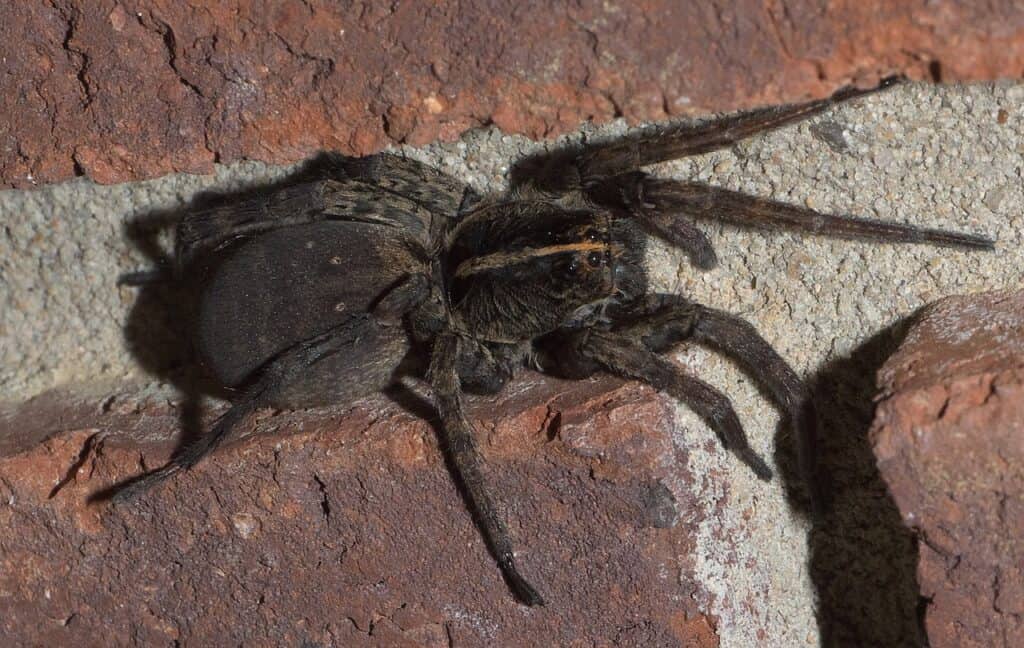
Unlike other spider species, wolf spiders do not build webs. Instead, like wolves, they actively hunt for their food.
©xpda / CC BY-SA 4.0 – License
The wolf spider is one of Arizona’s most widespread black spiders. With their robust bodies and long legs, these spiders traverse land and water for food. They cover large distances in a single night. They feed mainly on insects such as grasshoppers, crickets, and beetles. However, some larger specimens also hunt mice or lizards.
Unlike other spider species, wolf spiders do not build webs. Instead, like wolves, they actively hunt for their food. They also possess excellent vision, which helps them spot potential prey from a distance. Additionally, they are swift runners, allowing them to quickly pursue and catch any bug unfortunate enough to cross its path.
These spiders are generally harmless to humans unless provoked or threatened. However, they have potent venom that can be used defensively against attackers. Due to their ability to rapidly move across open spaces, they have become an iconic symbol of Arizona’s desert landscape. They often patrol their area looking for potential mates or prey.
6.) Arizona Black Hole Spider

It is usually almost completely black but can sometimes incorporate blonde markings.
©Tamberly Conway / CC BY 4.0 – License
The Arizona black hole spider, also known as the Kukulcania arizonica, is a spider species native to Arizona and neighboring states such as New Mexico, California, and Nevada. This unique small arachnid is easily recognizable. It is usually almost completely black but can sometimes incorporate blonde markings. Its body grows thick hair, which gives it a distinctive, almost velvety appearance.
Unlike other species of black spiders, the Arizona black hole spider prefers dry habitats, such as desert shrublands with plenty of insects to hunt. These spiders generally build orb webs close to the ground, which they use to trap their prey. If necessary, they will actively hunt instead of relying solely on their web.
Despite its small size, the Arizona black hole spider has a formidable reputation. Although its venom is not dangerous to humans, this spider has an unpredictable nature and potential to cause pain and nausea if provoked.
The photo featured at the top of this post is © Sari ONeal/Shutterstock.com
Thank you for reading! Have some feedback for us? Contact the AZ Animals editorial team.




